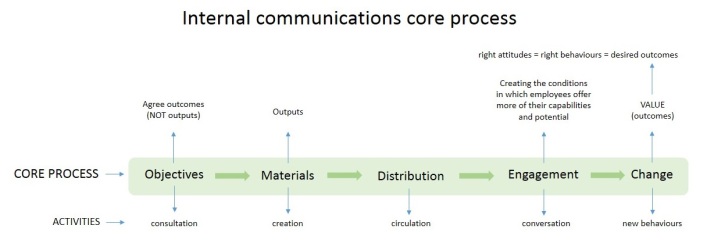In the world of internal communications we seem to spend our time tumbling or lurching from one activity (aka crisis!) to another. We don’t often spend time reflecting on what we’re really contributing, or our purpose inside organisations. This is a shame. It’s also very tiring as without a clear purpose we’re not always in a position to say: “NO”
So, I decided to spend a little time thinking about the purpose and value of internal communications inside organisations to reset and recalibrate my thinking. Below are some random meanderings on the subject.
What’s the point of internal comms?
I think internal comms is an invaluable organisational asset … and here’s why. Organisations are just groups of people. Both organisations as entities and people as individuals have needs. For example, an organisation needs to produce the stuff its customers want as efficiently and cheaply as possible … and people want to feel valued, respected and heard. Internal communications blends the needs of the organisation with the needs of its people so that stuff gets produced and the people enjoy producing it. Internal communications holds the organisational space. And, when the organisational needs change to meet the demands of its customers or the markets, internal communications helps people through that change so that everyone’s needs are still being met at the end of it.
In good organisations with successful internal communications teams, every employee believes they can make a difference … and, crucially, wants to make a difference.
What does internal comms do?
A very good question. Below is a rough sketch of what I think constitutes the internal communications core process:
In my experience, we’re not very good at the first step in this process – agreeing objectives. These need to be crystal clear and they need to be outcomes rather than outputs. As a profession, we have a bad reputation for measuring our outputs and equating the scale of these outputs with success.
What does good look like?
I think a healthy internal communications ecosystem looks something like this:
It should be a healthy balance of: stuff (collectively described in this diagram as ‘content’) -> getting to the right people in a timely fashion -> creating conversation -> which helps inform the next load of stuff … and so it goes on. Traditionally, we have been poor at the conversation bit of this which I think has limited the value we’ve delivered as a profession. However, with the advent of the so called social organisation, this is all changing. Once we’ve got this all ticking along nicely we can be assured that we all have a shared understanding of what is required, we feel engaged and change happens. If only it was that simple!
A bit more about value
Wow … this is really tricky! Effective internal comms is about doing some stuff (service delivery); forming relationships with stakeholders to help them solve their business problems (business partnering); and amazing the business with new and exciting thinking (leading change … aka innovating). Here’s a little diagram showing these activities which I’ve chosen to call the value triangle:
A good internal comms practitioner will need to do all of these things at various times … the trick is getting the balance right. I think the right balance is illustrated by the triangular shape of the model.
Conclusion
I don’t really have one. As I said at the start, these are fairly random meanderings which have helped me think about what I should be doing and how to balance the various activities/priorities demanded of me. One day, I plan to say “NO” to something. When I do, you’ll be the first to know! 🙂



If only I had a pound for every time an employee at some company had told me that they experienced poor communication within their organization. These days it’s almost expected, however distasteful that may seem.
Nice to see at least one person working hard on internal communication Richard 🙂